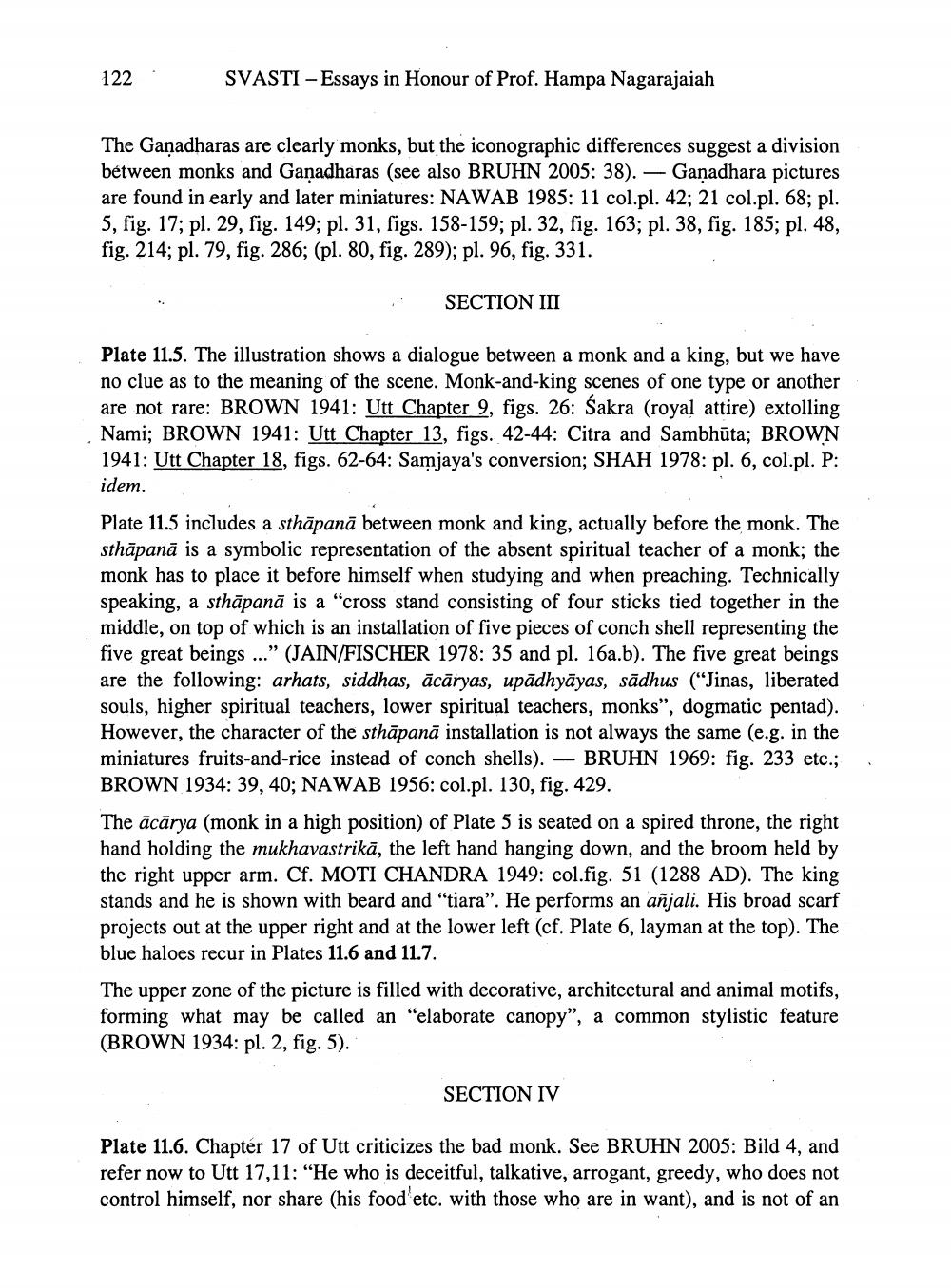________________
122
SVASTI -Essays in Honour of Prof. Hampa Nagarajaiah
The Ganadharas are clearly monks, but the iconographic differences suggest a division between monks and Ganadharas (see also BRUHN 2005: 38). - Gaṇadhara pictures are found in early and later miniatures: NAWAB 1985: 11 col.pl. 42; 21 col.pl. 68; pl. 5, fig. 17; pl. 29, fig. 149; pl. 31, figs. 158-159; pl. 32, fig. 163; pl. 38, fig. 185; pl. 48, fig. 214; pl. 79, fig. 286; (pl. 80, fig. 289); pl. 96, fig. 331.
SECTION III
Plate 11.5. The illustration shows a dialogue between a monk and a king, but we have no clue as to the meaning of the scene. Monk-and-king scenes of one type or another are not rare: BROWN 1941: Utt Chapter 9, figs. 26: Śakra (royal attire) extolling Nami; BROWN 1941: Utt Chapter 13, figs. 42-44: Citra and Sambhūta; BROWN 1941: Utt Chapter 18, figs. 62-64: Samjaya's conversion; SHAH 1978: pl. 6, col.pl. P: idem.
Plate 11.5 includes a sthāpanā between monk and king, actually before the monk. The sthapana is a symbolic representation of the absent spiritual teacher of a monk; the monk has to place it before himself when studying and when preaching. Technically speaking, a sthāpanā is a "cross stand consisting of four sticks tied together in the middle, on top of which is an installation of five pieces of conch shell representing the five great beings..." (JAIN/FISCHER 1978: 35 and pl. 16a.b). The five great beings are the following: arhats, siddhas, ācāryas, upadhyāyas, sädhus ("Jinas, liberated souls, higher spiritual teachers, lower spiritual teachers, monks", dogmatic pentad). However, the character of the sthäpană installation is not always the same (e.g. in the miniatures fruits-and-rice instead of conch shells). BRUHN 1969: fig. 233 etc.; BROWN 1934: 39, 40; NAWAB 1956: col.pl. 130, fig. 429.
-
The ācārya (monk in a high position) of Plate 5 is seated on a spired throne, the right hand holding the mukhavastrikā, the left hand hanging down, and the broom held by the right upper arm. Cf. MOTI CHANDRA 1949: col.fig. 51 (1288 AD). The king stands and he is shown with beard and "tiara". He performs an añjali. His broad scarf projects out at the upper right and at the lower left (cf. Plate 6, layman at the top). The blue haloes recur in Plates 11.6 and 11.7.
The upper zone of the picture is filled with decorative, architectural and animal motifs, forming what may be called an "elaborate canopy", a common stylistic feature (BROWN 1934: pl. 2, fig. 5).
SECTION IV
Plate 11.6. Chapter 17 of Utt criticizes the bad monk. See BRUHN 2005: Bild 4, and refer now to Utt 17,11: "He who is deceitful, talkative, arrogant, greedy, who does not control himself, nor share (his food etc. with those who are in want), and is not of an




